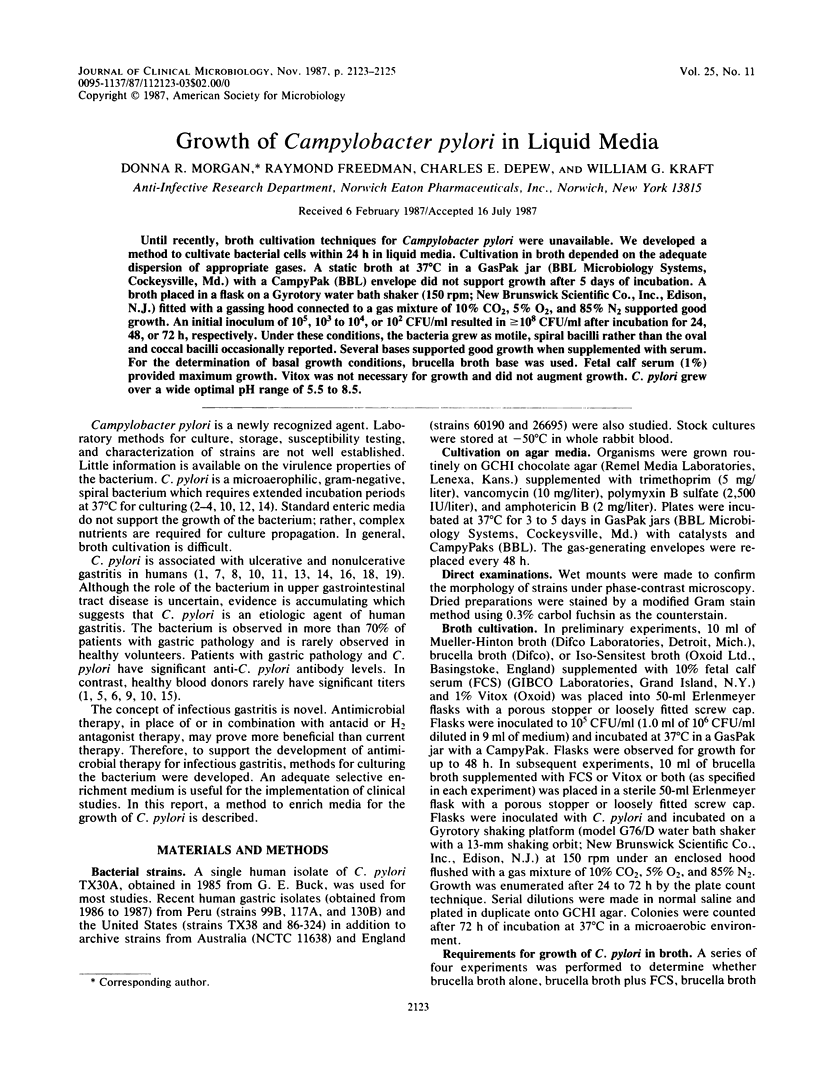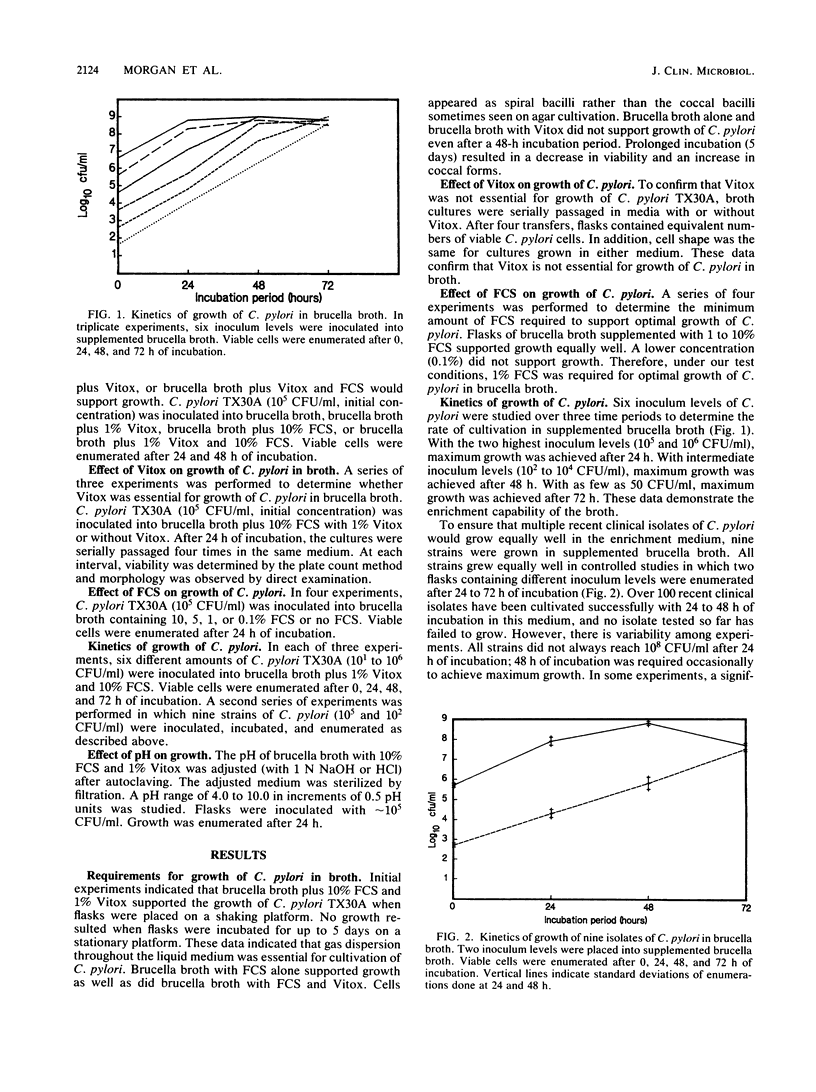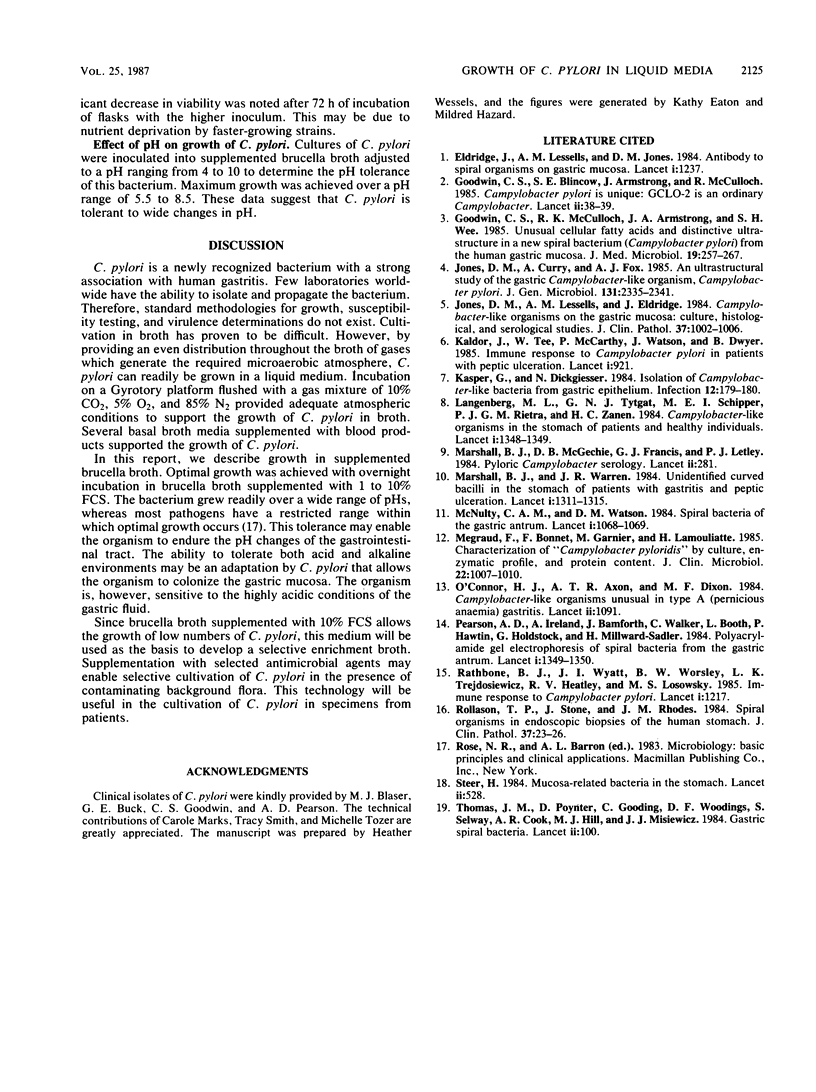Abstract
Until recently, broth cultivation techniques for Campylobacter pylori were unavailable. We developed a method to cultivate bacterial cells within 24 h in liquid media. Cultivation in broth depended on the adequate dispersion of appropriate gases. A static broth at 37 degrees C in a GasPak jar (BBL Microbiology Systems, Cockeysville, Md.) with a CampyPak (BBL) envelope did not support growth after 5 days of incubation. A broth placed in a flask on a Gyrotory water bath shaker (150 rpm; New Brunswick Scientific Co., Inc., Edison, N.J.) fitted with a gassing hood connected to a gas mixture of 10% CO2, 5% O2, and 85% N2 supported good growth. An initial inoculum of 10(5), 10(3) to 10(4), or 10(2) CFU/ml resulted in greater than or equal to 10(8) CFU/ml after incubation for 24, 48, or 72 h, respectively. Under these conditions, the bacteria grew as motile, spiral bacilli rather than the oval and coccal bacilli occasionally reported. Several bases supported good growth when supplemented with serum. For the determination of basal growth conditions, brucella broth base was used. Fetal calf serum (1%) provided maximum growth. Vitox was not necessary for growth and did not augment growth. C. pylori grew over a wide optimal pH range of 5.5 to 8.5.
Full text
PDF


Selected References
These references are in PubMed. This may not be the complete list of references from this article.
- Eldridge J., Lessells A. M., Jones D. M. Antibody to spiral organisms on gastric mucosa. Lancet. 1984 Jun 2;1(8388):1237–1237. doi: 10.1016/s0140-6736(84)91716-1. [DOI] [PubMed] [Google Scholar]
- Gastric spiral bacteria. Lancet. 1984 Jul 14;2(8394):100–101. [PubMed] [Google Scholar]
- Goodwin C. S., McCulloch R. K., Armstrong J. A., Wee S. H. Unusual cellular fatty acids and distinctive ultrastructure in a new spiral bacterium (Campylobacter pyloridis) from the human gastric mucosa. J Med Microbiol. 1985 Apr;19(2):257–267. doi: 10.1099/00222615-19-2-257. [DOI] [PubMed] [Google Scholar]
- Goodwin S., Blincow E., Armstrong J., McCulloch R., Collins D. Campylobacter pyloridis is unique: GCLO-2 is an ordinary campylobacter. Lancet. 1985 Jul 6;2(8445):38–39. doi: 10.1016/s0140-6736(85)90082-0. [DOI] [PubMed] [Google Scholar]
- Jones D. M., Curry A., Fox A. J. An ultrastructural study of the gastric campylobacter-like organism 'Campylobacter pyloridis'. J Gen Microbiol. 1985 Sep;131(9):2335–2341. doi: 10.1099/00221287-131-9-2335. [DOI] [PubMed] [Google Scholar]
- Jones D. M., Lessells A. M., Eldridge J. Campylobacter like organisms on the gastric mucosa: culture, histological, and serological studies. J Clin Pathol. 1984 Sep;37(9):1002–1006. doi: 10.1136/jcp.37.9.1002. [DOI] [PMC free article] [PubMed] [Google Scholar]
- Kaldor J., Tee W., McCarthy P., Watson J., Dwyer B. Immune response to Campylobacter pyloridis in patients with peptic ulceration. Lancet. 1985 Apr 20;1(8434):921–921. doi: 10.1016/s0140-6736(85)91687-3. [DOI] [PubMed] [Google Scholar]
- Kasper G., Dickgiesser N. Isolation of campylobacter-like bacteria from gastric epithelium. Infection. 1984 May-Jun;12(3):179–180. doi: 10.1007/BF01640894. [DOI] [PubMed] [Google Scholar]
- Marshall B. J., McGechie D. B., Francis G. J., Utley P. J. Pyloric campylobacter serology. Lancet. 1984 Aug 4;2(8397):281–281. doi: 10.1016/s0140-6736(84)90318-0. [DOI] [PubMed] [Google Scholar]
- Marshall B. J., Warren J. R. Unidentified curved bacilli in the stomach of patients with gastritis and peptic ulceration. Lancet. 1984 Jun 16;1(8390):1311–1315. doi: 10.1016/s0140-6736(84)91816-6. [DOI] [PubMed] [Google Scholar]
- McNulty C. A., Watson D. M. Spiral bacteria of the gastric antrum. Lancet. 1984 May 12;1(8385):1068–1069. doi: 10.1016/s0140-6736(84)91469-7. [DOI] [PubMed] [Google Scholar]
- Megraud F., Bonnet F., Garnier M., Lamouliatte H. Characterization of "Campylobacter pyloridis" by culture, enzymatic profile, and protein content. J Clin Microbiol. 1985 Dec;22(6):1007–1010. doi: 10.1128/jcm.22.6.1007-1010.1985. [DOI] [PMC free article] [PubMed] [Google Scholar]
- O'Connor H. J., Axon A. T., Dixon M. F. Campylobacter-like organisms unusual in type A (pernicious anaemia) gastritis. Lancet. 1984 Nov 10;2(8411):1091–1091. doi: 10.1016/s0140-6736(84)91523-x. [DOI] [PubMed] [Google Scholar]
- Pearson A. D., Ireland A., Bamforth J., Walker C., Booth L., Hawtin P., Holdstock G., Millward-Sadler H. Polyacrylamide gel electrophoresis of spiral bacteria from the gastric antrum. Lancet. 1984 Jun 16;1(8390):1349–1350. doi: 10.1016/s0140-6736(84)91837-3. [DOI] [PubMed] [Google Scholar]
- Rathbone B. J., Wyatt J. I., Worsley B. W., Trejdosiewicz L. K., Heatley R. V., Losowsky M. S. Immune response to Campylobacter pyloridis. Lancet. 1985 May 25;1(8439):1217–1217. doi: 10.1016/s0140-6736(85)92897-1. [DOI] [PubMed] [Google Scholar]
- Rollason T. P., Stone J., Rhodes J. M. Spiral organisms in endoscopic biopsies of the human stomach. J Clin Pathol. 1984 Jan;37(1):23–26. doi: 10.1136/jcp.37.1.23. [DOI] [PMC free article] [PubMed] [Google Scholar]


